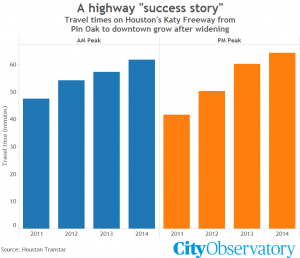Braess’ Paradox and the Katy Freeway
It’s reasonable to think that a valid solution to congestion would be to simply open a new road or lane for traffic, the thinking behind this being that opening a new lane of traffic divides the number of cars from two lanes of traffic to three lanes. This would in turn reduce the number of cars on a lane at any given time and lessening travel time. However, Braess’ Paradox states that the addition of a road to a congested network actually (and rather unintuitively) increases overall travel time. Furthermore, removing pieces of a malfunctioning network may sometimes even serve to improve the network overall.
Katy Freeway in Houston Texas experienced Braess’ paradox firsthand when the state of Texas spent nearly $2.8 billion expanding the freeway to 26 lanes (12 main, 8 feeder, and 6 managed lanes). Despite holding the title for the widest freeway on the planet, Katy Freeway’s congestion has actually worsened as commute times have increased by 10 to 20 minutes (Reyna). Despite the American Highway Users Alliance’s (AHUA) efforts to claim otherwise, Joe Cortright, writing for The Broken Sidewalk, compiled data from Houston’s official traffic tracking data source, Transtar, to show how morning and afternoon commutes on the Katy have increased by 23 to 25 minutes.
 Why is this the case? Why does adding lanes to a busy freeway actually serve to worsen the travel time? This is due to the phenomenon called induced demand. This asserts that adding freeway capacity simply induces longer trips, more sprawl, and more driving. By making new routes more convenient and convincing people they will get to work faster, adding new lanes encourages people who would not usually travel on the Katy Freeway (because of usual traffic congestion and severe bottle-necking) to use the freeway.
Why is this the case? Why does adding lanes to a busy freeway actually serve to worsen the travel time? This is due to the phenomenon called induced demand. This asserts that adding freeway capacity simply induces longer trips, more sprawl, and more driving. By making new routes more convenient and convincing people they will get to work faster, adding new lanes encourages people who would not usually travel on the Katy Freeway (because of usual traffic congestion and severe bottle-necking) to use the freeway.
While adding new lanes won’t solve the Katy Freeway issue, referring back to class discussion, one possible solution to solving the problem would be to introduce price incentives to reduce travel on the freeway during peak popular times. Increasing the price of tolls during these times would encourage drives to find other routes that are more cost-effective, which would in turn reduce the number of cars on the freeway and decrease travel time.
There is no easy solution to the Katy Freeway problem, but adding more lanes as Houston has done is definitely not the right answer according to Braess’ Paradox. Implementing an economic incentive may be the most cost-effective and simplest method to alleviating traffic and diminishing travel time.
Sources:
Cortright, Joe. “Reducing Congestion: Katy Didn’t: How 23 Lanes of Highway Induce Demand in Houston.” Broken Sidewalk. N.p., 23 Dec. 2015. Web. 11 Sept. 2016. <http://brokensidewalk.com/2015/induced-demand-in-action/>.
Reyna, Jennifer. “Houston Commute times Quickly Increasing.” KPRC. N.p., 23 Nov. 2015. Web. 11 Sept. 2016. <http://www.click2houston.com/news/houston-commute-times-quickly-increasing_20151123154243235>.
